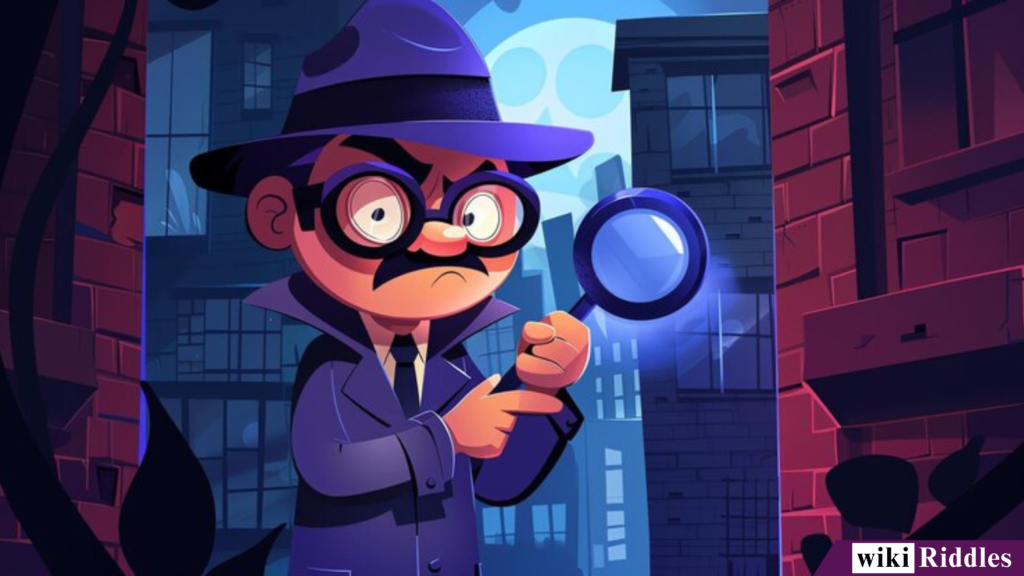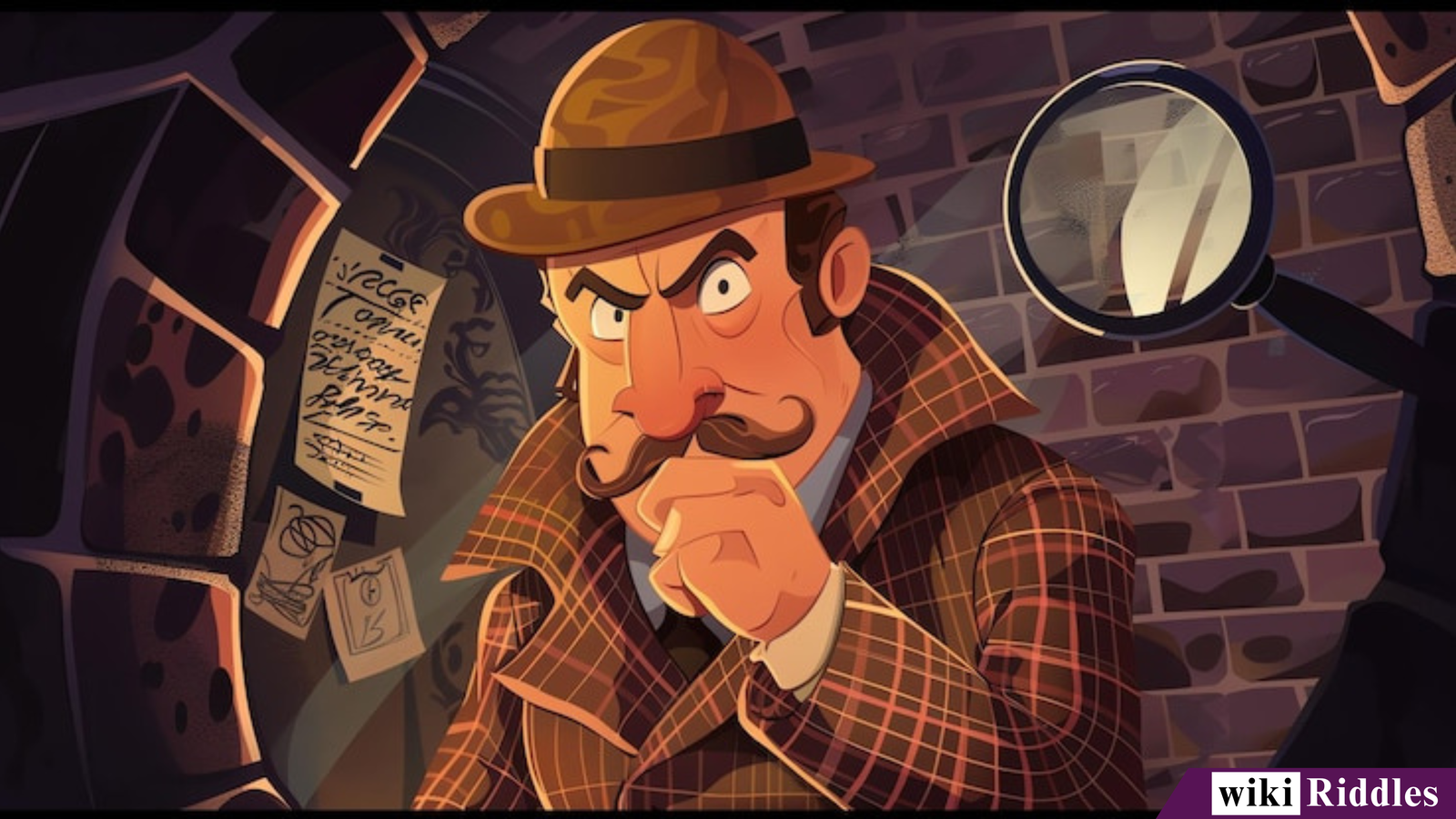Do you enjoy solving mysteries, catching liars, or finding hidden clues? If yes, then detective riddles are perfect for you. Detective riddles are short mystery puzzles that place you in the shoes of a detective. They give you a scenario, often involving a crime, a missing object, or a suspicious alibi, and your task is to figure out the truth using logic, observation, and reasoning. Unlike ordinary riddles that may rely on simple wordplay, detective riddles immerse you in realistic situations where every detail matters.
What makes detective riddles so fascinating is their ability to challenge both your analytical and creative sides. They require you to carefully study information, consider all possibilities, and think like an investigator. Whether you are a fan of classic mysteries like Sherlock Holmes or you simply love brain teasers, detective riddles offer a fun and rewarding way to test your wits.

250+ “Detective Riddles” with Answers
Murder Mysteries
- Riddle: A man was found murdered in his office. The suspects are Peter, Julie, Jason, and Sofia. On his desk was a calendar with numbers 6, 4, 9 written in blood. Who is the killer?
Answer: Jason. The numbers correspond to the letters J-A-S (6th, 1st, 19th letters). - Riddle: A detective finds a man dead with a gunshot wound. The gun is on the floor, but no gunpowder is on his hand. Was it suicide or murder?
Answer: Murder. A suicide would leave gunpowder residue on his hand. - Riddle: A woman was stabbed in her house. Neighbors say no one entered or left. How did the killer get away?
Answer: The killer was already inside the house, hiding. - Riddle: A man is found drowned in a pool, but his lungs are dry. How?
Answer: He was killed elsewhere, and his body was placed in the pool. - Riddle: A man is found dead with a note saying “No one will know.” Why did the detective call it staged?
Answer: Suicide notes usually have explanations, not cryptic threats. - Riddle: A woman is poisoned, but no poison is found in her food or drink. How did she die?
Answer: The poison was on the rim of her glass. - Riddle: A man is stabbed, yet there’s no blood at the scene. Why?
Answer: He was killed somewhere else, and the body was moved. - Riddle: A detective sees muddy footprints only leading into a room, not out. Where is the killer?
Answer: Still hiding inside the room. - Riddle: A man is killed with a bullet, but there’s no bullet hole in his clothes. How?
Answer: He was shot before getting dressed. - Riddle: A man dies in a locked cabin with no forced entry. How?
Answer: He committed suicide inside.
Alibi Riddles
- Riddle: A man claims he was home reading when a murder happened, but he could not say the ending of the book. Why is he lying?
Answer: He never read it. - Riddle: A suspect says he was at a movie, but the detective checks and finds the movie wasn’t showing that day. What does this prove?
Answer: His alibi is false. - Riddle: A woman claims she was asleep during a murder, but she described the storm outside. Why is that suspicious?
Answer: If she was asleep, she would not know about the storm. - Riddle: A man said he was at work all night, but his office had no power. How did he get caught?
Answer: He couldn’t have worked without lights. - Riddle: A suspect says he was at a bar, but couldn’t remember the bartender’s name. Why suspicious?
Answer: Regular customers know the bartender. - Riddle: A man said he was watching the news, but the detective knew the news wasn’t on. Why?
Answer: Wrong timing for the alibi. - Riddle: A woman claims she was cooking dinner, but no dishes or leftovers are found. What does that mean?
Answer: She lied. - Riddle: A man says he was jogging in the park, but his shoes are spotless. What does that prove?
Answer: He wasn’t jogging. - Riddle: A boy says he was at school, but it was a holiday. Why suspicious?
Answer: School wasn’t open. - Riddle: A man claims he was asleep, but he answered his phone during the time of the crime. Why is this a lie?
Answer: He couldn’t have been asleep.
Crime Scene Puzzles
- Riddle: A man is found hanging from the ceiling, but the floor is dry. How did he reach the rope?
Answer: He stood on a block of ice that melted. - Riddle: A woman is found shot in a locked bathroom. How was it murder?
Answer: The killer shot her through the window. - Riddle: A dead man holds a gun, but the window is open and footprints are outside. What happened?
Answer: Someone killed him and escaped. - Riddle: Blood is only on one side of the room. Why?
Answer: The crime occurred only in that corner. - Riddle: A man lies dead with scissors near him, but no wounds. How?
Answer: The scissors were a red herring. - Riddle: A body is found in the desert with only a backpack. What happened?
Answer: It was a parachute that failed. - Riddle: A crime scene shows spilled wine and broken glass. What does that mean?
Answer: The fight began at the table. - Riddle: A detective sees dust on all surfaces except one small circle. What does this mean?
Answer: An object was recently moved. - Riddle: A man dies of poison, but the glass is untouched. How?
Answer: The poison was in the ice. - Riddle: A detective finds muddy footprints but only one matches a suspect. Why?
Answer: The killer walked in socks to avoid leaving prints.
Logic Traps
- Riddle: A man says he never met the victim, but knew her name. Why suspicious?
Answer: He shouldn’t know her name. - Riddle: A man says he was outside, but his clothes are dry though it rained. Why suspicious?
Answer: He wasn’t outside. - Riddle: A woman said she found a body and screamed, but neighbors heard nothing. Why?
Answer: She never screamed. - Riddle: A man says he only touched the doorknob, yet his fingerprints are inside. Why suspicious?
Answer: He entered the house. - Riddle: A thief claims he stole nothing, but knew what was stolen. Why suspicious?
Answer: Only the thief would know. - Riddle: A man says he just met the victim, but recalls details about her house. Why suspicious?
Answer: He knew her well. - Riddle: A suspect said he ate at 9, but the crime happened at 8 and his food was still hot. Why suspicious?
Answer: He ate later. - Riddle: A man says he didn’t turn on the light, but fingerprints are on the switch. Why suspicious?
Answer: He turned it on. - Riddle: A woman says she never entered the victim’s car, but her purse is inside. Why suspicious?
Answer: She was in the car. - Riddle: A man says he saw nothing, but described the victim’s clothes. Why suspicious?
Answer: He lied.
Riddle Interrogations
- Riddle: A detective asks three suspects their whereabouts. One gives too many details. Why is that suspicious?
Answer: Overexplaining often means lying. - Riddle: One suspect says “I didn’t kill her.” Why suspicious?
Answer: No one mentioned murder yet. - Riddle: A man says, “I was home all night watching my favorite show.” The show wasn’t on. Why suspicious?
Answer: He invented the alibi. - Riddle: A suspect answered before the question was finished. Why suspicious?
Answer: He prepared the answer. - Riddle: A man claims he saw nothing, yet describes the room’s color. Why suspicious?
Answer: He was inside. - Riddle: A woman laughs nervously when asked if she was near the crime. Why suspicious?
Answer: Nervous laughter indicates lying. - Riddle: A suspect keeps repeating the same sentence word for word. Why suspicious?
Answer: Memorized story. - Riddle: A man says “If I killed him, I’d use poison.” Why suspicious?
Answer: He brought up killing himself. - Riddle: A woman claims she didn’t go near the victim, yet her fingerprints are found. Why suspicious?
Answer: Contradiction. - Riddle: A man says he never met the victim, but they are in photos together. Why suspicious?
Answer: He lied.
Forensic Clues
- Riddle: A body has no wounds, yet he was poisoned. How do we know?
Answer: Traces found in the stomach. - Riddle: A suspect says he wasn’t there, but his fingerprints are. Why suspicious?
Answer: Forensic proof places him there. - Riddle: A shoeprint is too small for the victim. What does this mean?
Answer: Another person was present. - Riddle: A bullet is found, but it doesn’t match the victim’s gun. What does this prove?
Answer: Another weapon was used. - Riddle: A blood sample has two DNA profiles. What does that mean?
Answer: The killer was injured. - Riddle: A glass shows lipstick, but the victim wore none. What does this prove?
Answer: Someone else drank from it. - Riddle: A body has rope burns, but no rope is present. Why suspicious?
Answer: The killer removed the rope. - Riddle: Hair fibers found don’t match the victim. What does this prove?
Answer: Another person was at the scene. - Riddle: A cigarette butt has DNA, but the suspect claims not to smoke. Why suspicious?
Answer: He smoked there. - Riddle: Mud on the victim’s shoes doesn’t match the scene. What does this mean?
Answer: The crime happened elsewhere.
Mystery Objects
- Riddle: A knife is clean, yet it’s the murder weapon. How?
Answer: The killer wiped it. - Riddle: A watch is stopped at 9:15. What does this suggest?
Answer: Time of death. - Riddle: A phone has a half-written text. What does this mean?
Answer: Victim was interrupted. - Riddle: A candle is still burning near a dead man. What does it show?
Answer: He died recently. - Riddle: A window is broken, but the glass is outside. What does it mean?
Answer: Break-in was staged. - Riddle: A diary ends mid-sentence. Why suspicious?
Answer: The victim was stopped suddenly. - Riddle: A glass has two straws, but the victim was alone. What does it suggest?
Answer: Someone else was there. - Riddle: A pillow near a body smells strange. Why?
Answer: It was used for suffocation. - Riddle: A rope is tied in a sailor’s knot. What does this suggest?
Answer: The killer knew sailing. - Riddle: A camera has missing footage. Why suspicious?
Answer: Someone deleted evidence.
Time-based Mysteries
- Riddle: A man dies at 10, but his clock stopped at 9. Why suspicious?
Answer: The killer tampered with the clock. - Riddle: A woman says she ate dinner at 6, but the food was cold at 7. Why suspicious?
Answer: She ate later. - Riddle: A suspect said he left at midnight, but his ticket shows 11. Why suspicious?
Answer: He left earlier. - Riddle: A man claims he called at 3, but records show 2. Why suspicious?
Answer: He lied. - Riddle: A body is warm though death was hours ago. Why suspicious?
Answer: The time of death was staged. - Riddle: A clock is shattered at 4:15. What does that mean?
Answer: Time of the struggle. - Riddle: A woman says she left at 7, but her car was seen at 8. Why suspicious?
Answer: She lied. - Riddle: A man says he was asleep, but sent an email at 2. Why suspicious?
Answer: He wasn’t asleep. - Riddle: A movie ticket shows 6 pm, but the murder happened at 6:15 nearby. Why suspicious?
Answer: He had time to commit the crime. - Riddle: A watch is missing from the victim’s wrist. Why suspicious?
Answer: The killer took it to alter the timeline.
Locked Room Mysteries
- Riddle: A man is found dead in a locked room with no key. How?
Answer: He locked it from inside before dying. - Riddle: A body is found, and the windows are sealed. How did the killer leave?
Answer: Through a secret passage. - Riddle: A candle was lit in a sealed room. What does this prove?
Answer: Someone lit it before leaving. - Riddle: A room has water on the floor and a hanging man. How?
Answer: He stood on ice. - Riddle: A locked bathroom has a dead body and a wet towel. How?
Answer: Killer escaped before it dried. - Riddle: A man is shot in a locked study. How?
Answer: Bullet came through the window. - Riddle: A victim lies near a locked door. How did the killer escape?
Answer: Through a trapdoor. - Riddle: A note says “suicide,” but no pen is in the room. What does this prove?
Answer: The killer planted it. - Riddle: A detective finds footprints only leading in. Where is the killer?
Answer: Still hiding inside. - Riddle: A room is locked, but the victim has no key. What does this mean?
Answer: The killer locked it after leaving, using the victim’s key.
Disguise & Identity
- Riddle: A man with a beard robs a store. The next day, police catch a clean-shaven man. How did the detective know it was him?
Answer: The beard was fake. - Riddle: A thief disguised himself as a waiter. What gave him away?
Answer: He served drinks on the wrong side. - Riddle: A masked man ran from the crime scene. How did the detective know who he was?
Answer: His shoes matched prints at the scene. - Riddle: A woman pretended to be left-handed to fool police. How was she caught?
Answer: She wore her watch on her left wrist, typical for right-handed people. - Riddle: A man posed as a doctor in a hospital. What exposed him?
Answer: He wore sneakers instead of medical shoes. - Riddle: A suspect changed his voice during questioning. What gave him away?
Answer: He coughed in his real voice. - Riddle: A man claimed to be a tourist, but the detective knew he was local. How?
Answer: He knew shortcuts only locals use. - Riddle: A woman dressed as a maid to sneak into a mansion. How was she discovered?
Answer: She used the wrong cleaning supplies. - Riddle: A suspect disguised himself as an old man. How did police know?
Answer: His hands were too young. - Riddle: A thief wore sunglasses at night. Why suspicious?
Answer: No one wears them in the dark.
Missing Person Cases
- Riddle: A girl vanished on her way home. Her bike was found, but not her shoes. What happened?
Answer: She was taken quickly before she could flee. - Riddle: A man disappears every Friday night but returns Saturday. Where was he?
Answer: At a secret gambling den. - Riddle: A woman went missing, yet her purse and phone were still at home. What does that suggest?
Answer: She didn’t leave willingly. - Riddle: A child vanishes at a fair. What clue helped detectives?
Answer: A balloon string was still tied to his wrist. - Riddle: A man is reported missing, but detectives find his passport missing too. What does that mean?
Answer: He left by choice. - Riddle: A missing person left the lights on and food cooking. What does that suggest?
Answer: They were taken suddenly. - Riddle: A girl went missing from her room, but the window was locked. How was she taken?
Answer: Through the door. - Riddle: A missing hiker’s shoes are found clean. What does that mean?
Answer: He never went hiking. - Riddle: A missing man’s car was found parked neatly. Why suspicious?
Answer: Kidnappers rarely park neatly. - Riddle: A missing woman’s dog was still tied outside. What does that suggest?
Answer: She didn’t plan to leave.
Disappearing Evidence
- Riddle: A murder weapon vanished from the scene. Where was it?
Answer: The killer threw it into a fire. - Riddle: Fingerprints disappeared from glass overnight. How?
Answer: The glass was wiped clean. - Riddle: Blood stains were missing from the carpet. Why?
Answer: The killer replaced the carpet. - Riddle: A document vanished from a desk. How?
Answer: It was shredded. - Riddle: Shoeprints disappeared outside. Why?
Answer: It rained. - Riddle: A photo vanished from a frame. How was the culprit caught?
Answer: Their fingerprints were on the glass. - Riddle: A confession letter burned halfway. How did police read it?
Answer: With chemical restoration. - Riddle: Security footage was missing. How?
Answer: The killer erased the tape. - Riddle: A bloody shirt vanished. Where was it found?
Answer: In a washing machine. - Riddle: Evidence disappeared from the detective’s desk. Who took it?
Answer: The prime suspect who visited earlier.
Poison Puzzles
- Riddle: A man drank coffee and died, but his friend drank the same and lived. How?
Answer: Poison was in the ice, which melted only in his cup. - Riddle: A woman died after drinking tea, yet the tea was safe. How?
Answer: The poison was on the cup’s rim. - Riddle: A man ate an apple and died. How?
Answer: Poison was in the seeds. - Riddle: Two men drank the same poisoned wine, but one survived. Why?
Answer: He drank quickly before the poison spread. - Riddle: A man died from poisoned chocolates, but his wife ate them too and lived. Why?
Answer: Only his chocolates were poisoned. - Riddle: A woman collapsed after eating soup, but the cook ate it too and was fine. Why?
Answer: Her spoon was poisoned. - Riddle: A king’s food was always tested for poison. How did he still die?
Answer: His napkin was poisoned. - Riddle: A prisoner took poison willingly but lived. How?
Answer: It was slow-acting and he got the antidote. - Riddle: A traveler drank from a stream and died. Why?
Answer: The stream was poisoned upstream. - Riddle: A man drank water and died instantly. Why?
Answer: Poison was inside the glass, not the water.
Coded Messages
- Riddle: A note says “5171320.” What does it mean?
Answer: Upside down it reads “OZIEILS” or “O lies.” - Riddle: A victim left “XIV” on the wall. What does it mean?
Answer: Roman numeral 14, pointing to the 14th suspect. - Riddle: A detective finds a message “RED RUM.” What does it mean?
Answer: Murder, spelled backward. - Riddle: A note says “1 5 12 16.” What does it spell?
Answer: HELP. - Riddle: The victim left “07:15” on his watch. What does it mean?
Answer: It points to a suspect’s birth date. - Riddle: A message says “COLD CASE HOT CLUE.” What is the hint?
Answer: The word HOT is out of place, pointing to fire. - Riddle: A note reads “E V I L.” Why suspicious?
Answer: Rearranged it says VILE. - Riddle: A diary entry has every third word circled. What does it reveal?
Answer: A hidden confession. - Riddle: The victim wrote numbers on the wall: 3 1 20. What does it spell?
Answer: CAT. - Riddle: A man received texts of random letters. What were they?
Answer: The first letters spelled out the killer’s name.
Heist Mysteries
- Riddle: A diamond was stolen from a locked case with no damage. How?
Answer: It was swapped earlier. - Riddle: A thief left muddy prints but no sign of entry. How did he get in?
Answer: Inside job. - Riddle: A bank vault was untouched, but money was missing. How?
Answer: The thief had the code. - Riddle: Jewelry vanished from a store, yet alarms never went off. Why?
Answer: The thief disabled them. - Riddle: A thief left a glove at the scene. Why suspicious?
Answer: It was planted to mislead. - Riddle: A gold bar was missing, but the case was locked. How?
Answer: The thief melted it and carried it in liquid form. - Riddle: A thief stole art during a blackout. How was he caught?
Answer: He used a flashlight visible to cameras. - Riddle: The thief left no footprints. How?
Answer: He walked backwards in the victim’s prints. - Riddle: A heist occurred during a parade. Why?
Answer: The noise masked the crime. - Riddle: A thief stole gems but left the box. Why?
Answer: To delay discovery.
Witness Testimonies
- Riddle: A witness said the killer wore red, but security shows blue. Why suspicious?
Answer: The witness lied. - Riddle: A man said he saw the crime at midnight, but it was dark. Why suspicious?
Answer: He couldn’t see in total darkness. - Riddle: A woman said she heard a shot, but the victim was stabbed. Why suspicious?
Answer: She was lying. - Riddle: A witness said the suspect ran left, but prints show right. Why suspicious?
Answer: False testimony. - Riddle: A man claimed he saw the suspect’s face clearly from far away. Why suspicious?
Answer: Too far to see details. - Riddle: A woman said she saw the victim alive after the murder. Why suspicious?
Answer: Impossible timeline. - Riddle: A man said the suspect wore gloves, but prints were found. Why suspicious?
Answer: He was covering for the suspect. - Riddle: A witness claimed he heard arguing, but the place was soundproof. Why suspicious?
Answer: He made it up. - Riddle: A man said the victim was smiling before dying. Why suspicious?
Answer: He was there at the murder. - Riddle: A woman said she called police right away, but records show 30 minutes later. Why suspicious?
Answer: She delayed on purpose.
False Clues (Red Herrings)
- Riddle: A bloody knife is found, but no blood matches the victim. Why?
Answer: It was planted. - Riddle: A wallet is at the scene, but the suspect was never there. Why?
Answer: Someone planted it. - Riddle: A note says “I did it,” but handwriting is wrong. Why suspicious?
Answer: It was forged. - Riddle: A gun is left at the scene, but it wasn’t fired. Why?
Answer: Fake clue. - Riddle: Jewelry is missing, but found in the victim’s drawer. Why?
Answer: Theft was staged. - Riddle: A shoeprint is too large for suspects. Why suspicious?
Answer: It was faked. - Riddle: A strand of hair is found, but the color doesn’t match. Why?
Answer: Wig hair. - Riddle: A glove is left behind, but it doesn’t fit anyone. Why?
Answer: Planted. - Riddle: A map is found with a circle, but it leads nowhere. Why?
Answer: Red herring. - Riddle: A letter confesses guilt, but the suspect was illiterate. Why suspicious?
Answer: Someone framed them.
Geography & Maps
- Riddle: A victim’s body was found uphill, but footprints go only down. Why?
Answer: The body was carried up. - Riddle: A map shows an X, but it’s not treasure. What is it?
Answer: Crime location. - Riddle: A man said he drove north, but the sun was setting in front of him. Why suspicious?
Answer: He was going west. - Riddle: A crime happened in one city, but the suspect had mud from another. Why suspicious?
Answer: He traveled there. - Riddle: A victim’s phone pinged near a lake, but her body was in town. Why suspicious?
Answer: Body was moved. - Riddle: A thief said he never left town, but his car had highway toll receipts. Why suspicious?
Answer: He lied. - Riddle: A map with marks was found. What was it?
Answer: The killer’s travel plan. - Riddle: A man said he never visited the cabin, but his GPS history showed it. Why suspicious?
Answer: Proof he went. - Riddle: A detective noticed the killer drew the map upside down. Why suspicious?
Answer: Only locals know the real orientation. - Riddle: A man claimed he was lost, but had a perfect map of the area. Why suspicious?
Answer: He wasn’t lost.
Behavioral Clues
- Riddle: A suspect avoided eye contact when asked about the crime. What does that suggest?
Answer: Guilt. - Riddle: A man kept changing his story. Why suspicious?
Answer: He was lying. - Riddle: A woman smiled when asked about the victim. Why suspicious?
Answer: Strange reaction to tragedy. - Riddle: A suspect kept fidgeting during questioning. Why suspicious?
Answer: Nervous behavior. - Riddle: A man kept glancing at the exit. Why suspicious?
Answer: He wanted to flee. - Riddle: A suspect became defensive quickly. Why suspicious?
Answer: Guilt showing. - Riddle: A woman answered too fast, before hearing the question. Why suspicious?
Answer: She rehearsed her lies. - Riddle: A suspect refused to touch anything. Why suspicious?
Answer: Afraid to leave prints. - Riddle: A man pretended to cry, but no tears came. Why suspicious?
Answer: Fake emotions. - Riddle: A suspect spoke in past tense about the victim before police confirmed death. Why suspicious?
Answer: He already knew.
Double-Cross Mysteries
- Riddle: Two thieves planned a heist. One disappeared with all the money. How was he caught?
Answer: He used the stolen money to buy a new car the next day. - Riddle: A detective found two sets of fingerprints on the stolen jewels. Why is that suspicious?
Answer: One thief betrayed the other and framed him. - Riddle: A partner promised to split the loot but vanished. What gave him away?
Answer: His share was found in his own locker. - Riddle: A gang blamed an outsider, but the evidence pointed to one of their own. What was the clue?
Answer: Only an insider knew the alarm code. - Riddle: A thief told police the leader escaped with the cash. How did detectives know he was lying?
Answer: The leader was already dead. - Riddle: Two criminals accused each other. What made the detective believe one over the other?
Answer: Only one gave details never released to the public. - Riddle: A robber said his partner fired the shot. How was he exposed?
Answer: Gunpowder was on his own hands. - Riddle: Two burglars swore they never met, but police proved otherwise. How?
Answer: They were photographed together last week. - Riddle: A man told police his friend tricked him into the crime. How was the lie uncovered?
Answer: Both had matching masks prepared. - Riddle: A thief said his partner ran away with everything. What proved him guilty?
Answer: His partner’s body was found nearby.
Cold Case Riddles
- Riddle: A wallet was found decades later in an old building. How did this help solve a case?
Answer: It belonged to a missing person. - Riddle: A diary from 20 years ago revealed a hidden name. What did it show?
Answer: The real killer’s identity. - Riddle: An old photo showed a victim alive after their supposed death. What did it prove?
Answer: The case was misdated. - Riddle: A rusted gun was found with initials. Why important?
Answer: It matched an unsolved shooting. - Riddle: A cold case was solved when DNA on a letter matched someone alive today. How?
Answer: The descendant shared the DNA. - Riddle: A ring found in the woods reopened a case. Why?
Answer: It matched the missing person’s jewelry. - Riddle: A confession note appeared years later. Why suspicious?
Answer: The handwriting matched an old suspect. - Riddle: A car pulled from a river solved a missing case. How?
Answer: The victim was inside. - Riddle: A coded message in police archives was cracked years later. What did it reveal?
Answer: The killer’s location. - Riddle: A witness finally admitted they lied decades ago. What did that do?
Answer: It cleared an innocent man.
Secret Rooms & Passageways
- Riddle: A man disappeared from a locked mansion. How?
Answer: Through a hidden passage. - Riddle: Police searched every room, yet the thief was inside. Where?
Answer: Behind a secret wall. - Riddle: A victim vanished during dinner. How?
Answer: A trapdoor under the table. - Riddle: A house had no basement, yet a man hid below. How?
Answer: A hidden staircase led underground. - Riddle: A killer escaped a locked library. How?
Answer: Through a revolving bookshelf. - Riddle: A child went missing but was still in the house. Where?
Answer: In a hidden attic. - Riddle: Police couldn’t find stolen gold. Where was it?
Answer: In a hollow wall. - Riddle: A thief disappeared in front of guards. How?
Answer: Through a concealed tunnel. - Riddle: A suspect claimed he was never inside the house, yet mud from a hidden tunnel was on his shoes. What does that mean?
Answer: He used the passage. - Riddle: A prisoner escaped a cell with no exit. How?
Answer: Through a secret hole behind the bed.
Financial Crimes
- Riddle: A man claimed he lost money gambling, but detectives arrested him. Why?
Answer: His bank transfers showed embezzlement. - Riddle: A woman said she earned cash legally, yet police knew it was fake. How?
Answer: Serial numbers were identical. - Riddle: A businessman had huge profits but no customers. What did that prove?
Answer: Money laundering. - Riddle: A thief deposited stolen money right after a robbery. How was he caught?
Answer: The bills were marked. - Riddle: A cashier stole but wasn’t seen. How was it proven?
Answer: Registers never balanced at her shift. - Riddle: A man bought property far above its value. Why suspicious?
Answer: Classic laundering method. - Riddle: A CEO lived lavishly but his company was failing. Why suspicious?
Answer: He was stealing funds. - Riddle: A suspect had no job but owned five cars. Why suspicious?
Answer: His wealth came from crime. - Riddle: A manager forged signatures. How was he caught?
Answer: Handwriting experts exposed him. - Riddle: A thief used a stolen credit card but claimed innocence. What proved him guilty?
Answer: Security cameras at the store.
Mystery Letters & Diaries
- Riddle: A victim’s diary ended mid-sentence. What does it mean?
Answer: They were interrupted by the killer. - Riddle: A letter had invisible ink. How was it revealed?
Answer: Heat exposed the words. - Riddle: A diary used strange symbols. What did it hide?
Answer: A secret lover’s name. - Riddle: A torn page from a diary solved the crime. Why?
Answer: It mentioned the suspect’s meeting. - Riddle: A letter claimed to be from the victim after death. Why suspicious?
Answer: Postmark was after the murder. - Riddle: A coded diary entry listed numbers. What did it reveal?
Answer: Phone numbers of accomplices. - Riddle: A diary described a place in detail. Why suspicious?
Answer: Only the killer knew it. - Riddle: A letter to police had spelling errors. Why important?
Answer: They matched a suspect’s writing style. - Riddle: A diary said “I fear tomorrow.” Why critical?
Answer: It predicted the exact day of the murder. - Riddle: A man received threatening letters but kept them hidden. Why suspicious?
Answer: He wrote them himself.
Chain of Clues
- Riddle: A muddy bootprint led to a torn glove, then to a missing button. What did it prove?
Answer: All belonged to the suspect. - Riddle: A broken lock, scattered papers, and missing cash pointed to what?
Answer: A staged burglary. - Riddle: A trail of cigarette butts, beer cans, and footprints revealed what?
Answer: The killer’s hiding spot. - Riddle: A scratched car, fabric on a fence, and blood drops led to what?
Answer: The hit-and-run driver. - Riddle: A burned match, ashes, and a lighter pointed to what?
Answer: Arson. - Riddle: Muddy footprints, wet clothes, and a missing boat showed what?
Answer: Escape by river. - Riddle: A note, a train ticket, and a suitcase revealed what?
Answer: The suspect planned to flee. - Riddle: A phone call, a car rental, and gas receipts revealed what?
Answer: A cross-country escape. - Riddle: A missing ring, a pawn shop ticket, and cash revealed what?
Answer: The thief pawned the ring. - Riddle: A knife sheath, fingerprints, and matching wounds revealed what?
Answer: The killer’s weapon.
What Are Detective Riddles
Detective riddles are puzzles presented in the form of short mystery stories. The setup usually introduces a problem, such as a suspicious death, a theft, or a strange event, along with a few clues. Your job is to analyze the scenario and come up with the correct solution. Sometimes the answer is obvious if you pay close attention, but often it requires lateral thinking or recognizing a hidden detail.
Why Do People Love Solving Them
People love solving detective riddles because they mix entertainment with challenge. Cracking a riddle feels like solving a mini crime case. It gives you a rush of accomplishment and often sparks curiosity to try the next one. Unlike long novels, detective riddles deliver quick bursts of mystery that you can solve in minutes. They are fun to play alone, share with friends, or use as a group activity where everyone tries to figure out the answer.
The Benefits of Solving Detective Riddles
Detective riddles are more than just puzzles. They work as powerful mental exercises that sharpen your brain while keeping you entertained.
- Boosts Critical Thinking
To solve a detective riddle, you must analyze the evidence, evaluate the credibility of statements, and make logical connections. This builds strong critical thinking skills, which help in academic work, career decisions, and even daily life situations where judgment is needed.
- Enhances Problem-Solving Skills
Detective riddles present problems that do not always have straightforward answers. They force you to look at the situation from different angles. This enhances your ability to solve problems creatively and logically, which is useful in both personal and professional life.
- Improves Memory and Focus
Detective riddles often contain many small details such as times, locations, and character actions. Solving them requires focus and memory retention. Practicing these riddles regularly strengthens your ability to concentrate and improves short-term memory.
- Fun and Engaging Learning
Unlike routine learning methods, detective riddles are interactive and fun. They teach logical reasoning, observation, and patience in a playful way. This is why teachers often use them in classrooms to engage students, and why parents introduce them to children as a form of educational entertainment.
A Brief History of Detective Riddles
The idea of riddles is ancient, but detective-style riddles emerged much later, shaped by the popularity of mystery stories.
- Ancient Puzzle Traditions
Riddles have existed for thousands of years. From the riddle of the Sphinx in Greek mythology to riddles found in old Norse texts, they were used as a way to test intelligence. While these riddles were not detective-themed, they introduced the concept of solving puzzles through logic and observation.
- Riddles in Detective Fiction
The modern detective riddle owes much to detective fiction. When Sir Arthur Conan Doyle created Sherlock Holmes, readers became fascinated with solving crimes using reasoning. Soon after, authors like Agatha Christie popularized whodunit mysteries where readers were encouraged to guess the culprit before the detective revealed the answer. This inspired smaller, riddle-sized versions of mysteries that could be enjoyed quickly without reading a full novel.
- Modern Online Detective Riddles
Today, detective riddles are everywhere. The internet has transformed them into viral content. On social media, users challenge their followers with quick detective riddles that spark engagement. On YouTube, entire channels present animated riddles where viewers must pause to solve before the solution is revealed. Mobile apps now include detective riddle games that combine storytelling with interactive choices. Detective riddles have truly evolved into a global form of entertainment.
Popular Types of Detective Riddles
Detective riddles can take many forms, each offering a different challenge.
- Crime Scene Mysteries
These riddles present you with a crime scene and a few details about what was found. You must figure out what really happened. For example, why is a glass broken near the victim? Why is the window open in the middle of winter? Every object could be a clue.
- Logic-Based Riddles
Logic riddles require you to carefully analyze statements and look for contradictions. They often include multiple suspects, each giving an alibi. Only by spotting the logical inconsistency can you identify the culprit.
- Whodunit Scenarios
These are classic detective riddles where you must figure out who committed the crime. You are given suspects, motives, and clues. The fun lies in piecing everything together to solve the mystery.
- Escape Room Puzzles
Inspired by real-life escape rooms, these riddles place you in a locked situation. You must use the clues around you to escape. They mix detective reasoning with puzzle-solving and are especially popular in mobile games.
Famous Detective Riddles and Examples
Examples make detective riddles more exciting and help you understand how they work.
- Classic Murder Mystery Riddle
A man is found dead in a locked room. The only window is open and there is water on the floor. The door was locked from the inside. How did he die?
Answer: He was standing on a block of ice that melted, leaving only water behind.
- Stolen Item Riddle
A teacher loses her watch during class. She asks three students. One says he was reading, another says he was drawing, and the third says he was watching the clock. Who stole it?
Answer: The third student, because he claimed to watch the clock that was already stolen.
- Alibi Riddle
Four suspects are questioned about a robbery. One says he was sleeping, another says he was cooking dinner, the third says he was watching television, and the fourth says he was reading a book. The robbery happened at midnight, and only one alibi makes sense. Who is lying?
Answer: The one who said he was cooking dinner. Nobody cooks dinner at midnight.
- Sherlock Holmes Inspired Riddle
A woman tells Holmes that she lost her wallet while walking to work. She claims it was stolen on a quiet street with no one around. Holmes replies, “You are lying.” Why?
Answer: If no one was around, then no one could have stolen the wallet.
How to Solve Detective Riddles Effectively
Solving detective riddles requires strategy.
- Pay Attention to Details
Read carefully. Often the answer lies in one small detail that is easy to overlook.
- Eliminate Wrong Options
If the riddle gives multiple possibilities, cross off the ones that are impossible. This narrows down the answer.
- Think Outside the Box
Detective riddles love tricking the reader. The most obvious answer is usually wrong. Be ready to think creatively.
- Practice Regularly
The more detective riddles you solve, the better you become at spotting clues and identifying patterns.
Creating Your Own Detective Riddles
Creating riddles is as fun as solving them.
- Building a Strong Scenario
Start with a simple case, such as a theft or an unusual event. Make sure it includes a problem and enough clues to solve it.
- Adding Twists and Red Herrings
To make your riddle challenging, add misleading details that distract the solver. A good riddle always includes at least one red herring.
- Testing the Riddle on Others
Share your riddle with friends before publishing it. If everyone solves it too quickly, add more complexity. If no one solves it, simplify it slightly.
Detective Riddles for Kids vs Adults
Detective riddles come in different difficulty levels.
- Simple Detective Riddles for Children
Children’s riddles are short and focus on observation. For example: “If a rooster lays an egg on the roof, which side will it roll down?” Answer: None, because roosters do not lay eggs. These riddles help kids build logical thinking in a playful way.
- Complex Detective Riddles for Adults
Adult riddles involve multiple layers of clues and demand critical reasoning. They are designed to keep the solver engaged for longer and often include psychological twists.
Why Detective Riddles Are Trending Online
Detective riddles have become a major online trend.
- Social Media Challenges
On platforms like Instagram and TikTok, quick detective riddles often go viral as challenges. People enjoy competing to see who solves them first.
- YouTube and Riddle Channels
YouTube channels dedicated to riddles have millions of views. Their engaging format allows viewers to pause, think, and solve before the solution is revealed.
- Puzzle Apps and Games
Mobile games now offer interactive detective riddles where players must solve multiple cases to progress. This gamified approach makes riddles even more addictive.
Conclusion
Wrapping it up, these 250+ detective riddles with answers are a fantastic way to sharpen your critical thinking, improve your observation skills, and enjoy some brain-boosting fun. Whether you’re solving them alone, challenging your friends, or using them in a classroom setting, these riddles are sure to keep your mind engaged. If you loved these detective puzzles, you’ll definitely enjoy exploring our collection of 250+ Fun “Shadow Riddles” with Answers for even more exciting challenges.
FAQs
Q. What are the hardest detective riddles
The hardest detective riddles are those with misleading clues, multiple suspects, and hidden twists that require careful reasoning to solve.
Q. Are detective riddles good for brain training
Yes, detective riddles improve critical thinking, focus, memory, and logical reasoning, making them excellent brain training exercises.
Q. Can children solve detective riddles
Yes, children can enjoy simple detective riddles designed for their age. These help kids develop logical skills in a fun way.
Q. Where can I find more detective riddles online
You can find detective riddles on puzzle websites, YouTube channels, mobile apps, and social media platforms.
Q. How can I create a detective riddle for friends
To create your own riddle, start with a simple mystery, add clues and red herrings, and test it with others to ensure it is solvable yet challenging.










